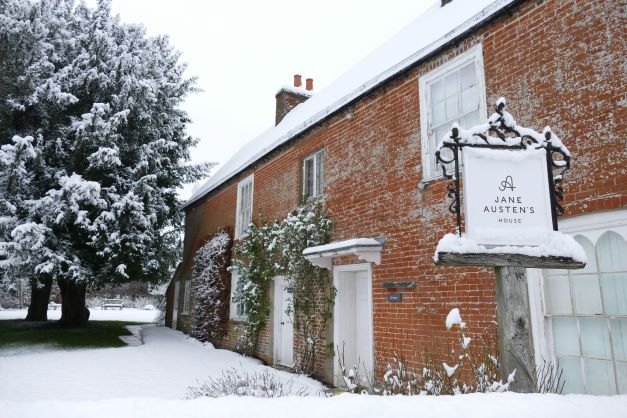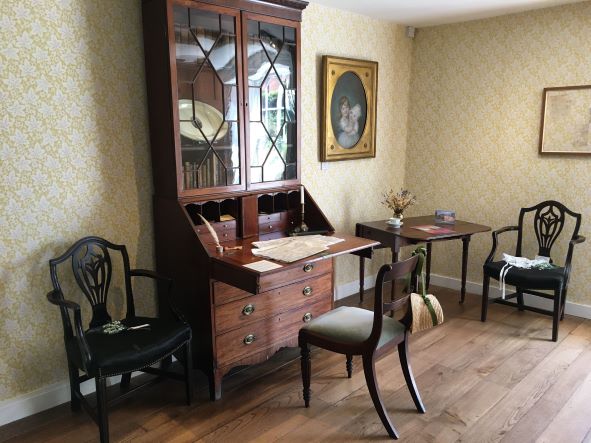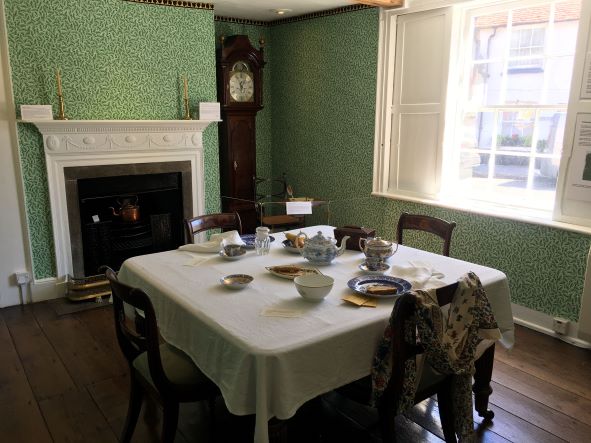Interview by Marian Olney
We’re lucky to have recently interviewed Rebecca Wood, Museum Assistant at Jane Austen’s House in Chawton, Hampshire. Here she tells us all about her role at the museum, what you can expect to find there and why Austen’s novels are still so relevant to readers and students today.
1. Could you tell us about your role at Jane Austen’s House and what you love about working there?
My role at Jane Austen’s House is Museum Assistant. This means I get to help with a variety of things. I work in the Collections department, helping put out objects for exhibitions and displays, I help run events like special tours, village walks, and virtual tours, and I lead sessions for school visits!
There are a lot of things to love about working here, but mainly I love sharing Jane Austen with people. Whether they’re an ardent fan already or don’t know too much about her, the chance to tell stories about her life is one of my favourite things.
2. What can a school expect from a visit to the house?

A school visit can expect a warm and enthusiastic welcome to the house, from staff members that are knowledgeable and passionate. The students are encouraged to ask questions throughout as we want them to get the most they can out of a visit here. Schools can enjoy a variety of sessions, whether that’s a tour around the house, a village walk, or a creative writing workshop to name a few.
Visiting Jane’s house really helps to make her books more engaging and feel more real. When students hear about Jane’s own life, her novels make more sense, and they can understand the whole Regency era better. For example, if you’re wondering why Mrs Bennet is so focused on getting her daughters married, hearing that Jane, her mother and her sister were left without a home when their father died makes it much more real.
3. Are there any special objects or documents linked to the set texts Pride and Prejudice and Northanger Abbey in the house?

One of our most special objects is Jane’s writing desk. It’s in the Dining Room, and it’s always so awe-inspiring to see where she wrote and revised these books that are still so celebrated over 200 years later. We’ve also got first editions of both novels, including a copy of Pride and Prejudice owned by Jane’s brother, Edward, whose wealthy lifestyle helped introduce her to the world of men like Mr Darcy.
We also have a few portraits of people that might have served as an inspiration for some of Jane’s characters – including Jane’s cousin, a clergyman with a reputation for being tactless who sounds rather like Mr Collins. There are also some pieces of furniture from her childhood home, Steventon, which was pretty similar to Catherine Morland’s home in Fullerton.
4. What do you think makes Jane Austen relevant to students studying her works today?
She creates such a variety of characters, whether it’s the bright and confident Lizzy Bennet, or the more introverted and awkward Catherine Morland. They’re all people you could meet in any time period. The novels might be set in the Regency era, but so much about them is universal, from being wrong about a first impression of someone, to the anxiety of going to a party and not knowing anyone.
One thing I really love about Jane Austen is how much her characters grow throughout her novels. The Mr Darcy and Lizzy you meet at the start of the novel are very different to the Mr Darcy and Lizzy you have at the end. She really appreciates the complexity of people and their potential for growth, which is valued now more than ever. A love of Jane Austen really does stay with people throughout their lives, which is such a lovely thing.
5. Finally, what do you think is the most special time to visit Jane Austen’s house and why?

Jane Austen's house in the spring and summer is particularly beautiful. We have an amazing garden here, and it's really a sight to behold when all the flowers are blooming. The house is much brighter and more spacious than people expect, which is only enhanced in the natural sunlight. The village of Chawton is really charming on a summer’s day too, with all the parkland and thatched cottages.
Photo credit: Jane Austen's House
Do you want to learn how you or your students can ace Jane Austen's classics in the exams? York Notes print and digital study guides are packed with useful information covering everything from key quotations, sample exam questions and quizzes. Check out the links below or search for Jane Austen for our full range of study guides and workbooks for GCSE, A-Level, and undergraduate students.
York Notes for GCSE Pride and Prejudice study guide
York Notes for GCSE Pride and Prejudice workbook
York Notes for A Level Pride and Prejudice study guide